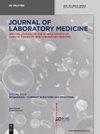The quality and quantity of compounds affected by viral inactivation methods in dried blood spots
IF 1.1
4区 医学
Q4 MEDICAL LABORATORY TECHNOLOGY
引用次数: 0
Abstract
Abstract Objectives The aim is to evaluate the effect of viral inactivation methods on the quality and quantity of compounds in dried blood spots (DBS). Methods Three effective and common inactivation methods were selected via the literature search, including: heating at 56 °C for 30 min, irradiation with UVC for 30 min, and surface wetting with 70 % ethanol. The concentration and clinical predicting significance of hormones, amino acids, and acylcarnitines from DBS were assessed, and the quality and quantity of extracted deoxyribonucleic acid (DNA) from DBS were evaluated. Results Compared to control, we found that there was no significant difference on hormones concentration in the DBS treated by heating at 56 °C for 30 min (thyroid stimulating hormone p=0.36, 17-hydroxyprogesterone p=0.52). And heating at 56 °C for 30 min had a minimal changed coefficient of variation on the concentration of amino acids and acylcarnitines. All three inactivation methods slightly changed the yield of DNA extraction, but did not affect the quality of the DNA. Importantly, the three inactivation methods wouldn’t change the clinical predicting significance of above-compounds mostly, especially heating at 56 °C for 30 min. Conclusions Considering the minimal effect on the quality and quantity of various compounds, the contaminated DBS could be pretreated by the three inactivation methods, as temporary emergency inactivation methods, especially heating at 56 °C for 30 min.干血斑中病毒灭活方法对化合物质量和数量的影响
摘要目的评价不同病毒灭活方法对干血斑(DBS)中化合物质量和数量的影响。方法通过文献检索,选择3种有效、常用的灭活方法:56℃加热30 min、UVC照射30 min、70%乙醇表面润湿。评估DBS中激素、氨基酸和酰基肉碱的浓度和临床预测意义,并评估DBS中提取的脱氧核糖核酸(DNA)的质量和数量。结果与对照组相比,经56°C加热30 min处理的DBS中激素浓度无显著差异(促甲状腺激素p=0.36, 17-羟孕酮p=0.52)。在56°C下加热30分钟对氨基酸和酰基肉碱浓度的变化系数最小。三种失活方法对DNA提取率有轻微影响,但不影响DNA的质量。重要的是,这三种失活方法大多不会改变上述化合物的临床预测意义,特别是在56°C下加热30 min。结论考虑到对各种化合物的质量和数量影响最小,污染的DBS可以通过三种失活方法进行预处理,作为临时应急失活方法,特别是在56°C下加热30 min。
本文章由计算机程序翻译,如有差异,请以英文原文为准。
求助全文
约1分钟内获得全文
求助全文
来源期刊

Journal of Laboratory Medicine
Mathematics-Discrete Mathematics and Combinatorics
CiteScore
2.50
自引率
0.00%
发文量
39
审稿时长
10 weeks
期刊介绍:
The Journal of Laboratory Medicine (JLM) is a bi-monthly published journal that reports on the latest developments in laboratory medicine. Particular focus is placed on the diagnostic aspects of the clinical laboratory, although technical, regulatory, and educational topics are equally covered. The Journal specializes in the publication of high-standard, competent and timely review articles on clinical, methodological and pathogenic aspects of modern laboratory diagnostics. These reviews are critically reviewed by expert reviewers and JLM’s Associate Editors who are specialists in the various subdisciplines of laboratory medicine. In addition, JLM publishes original research articles, case reports, point/counterpoint articles and letters to the editor, all of which are peer reviewed by at least two experts in the field.
 求助内容:
求助内容: 应助结果提醒方式:
应助结果提醒方式:


